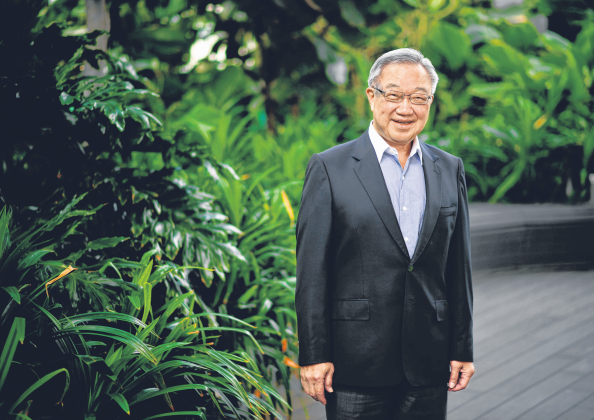
News Room
Raffles Medical looks beyond Covid-19
2021-05-01BY JANICE HENG (The Business Times)

“We are hardly geared. So we’ll go and borrow, if we need to borrow, for our capex, so that our balance sheet will be a bit more efficient,” says Dr Loo. BT PHOTO: CHONG JUN LIANG
Other than growth, its focus this year is on “regular business” and the return of patients – perhaps not just local, but foreign.
The past year was a tale of two halves for Raffles Medical Group, which emerged from a pandemic-hit first half to manage solid growth in the second.
But while being part of the country’s Covid-19 fight may cushion the topline, the firm is not counting on such “pandemic business”, said executive chairman Loo Choon Yong as he said the group “certainly hopes to get back to our business as usual”.
Last year, Covid-19 efforts were “a significant percentage, but not a lot” of revenue, he said. And as the situation improves, pandemic-related business will reduce, he added.
Similarly, Raffles Medical’s vaccination efforts, with 13 centres now, are more about the greater good than the figures.
“It will help us at least have some topline, but compared to say a consultation, it’s not a lot of money,” said Dr Loo.
“This cannot be a business,” he quipped. Rather, it is a cause. “We believe in this. We want Singapore to become Covid-free as soon as possible,” he said.
The Covid year
In the first half of 2020, Raffles Medical was hit by lockdowns across its network, deferments of elective surgeries, and travel restrictions that meant most foreign patients – who accounted for some 25 to 30 per cent of revenue pre-Covid – could not come.
Yet it kept busy. Doctors, nurses, and support staff joined national efforts, from border screening and testing to working at community isolation facilities.
At Raffles Hospital, beds normally filled by foreign patients did not lie empty for long. Under its Emergency Care Collaboration with the Ministry of Health, the hospital received five to six times more subsidised acute patients than usual.
The group also started new services such as Covid-19 polymerase chain reaction and serology testing.
As reopening began, “part of the work that was lost or deferred came back in the second half”, said Dr Loo.
“The second half was busy, attending to our patients who had deferred, and then some of this supporting the government’s efforts. That’s why we ended the year quite okay.”
In H1 2020, revenue fell 5.4 per cent and profit after tax and minority interest (Patmi) fell 38.2 per cent. But for the full year ended Dec 31, revenue was up 8.8 per cent at S$568.2 million, and Patmi grew 9.3 per cent to S$65.9 million.
This year, the focus is “regular business” and the return of patients – perhaps not just local, but foreign.
“We hope that, as we are able to maintain our situation in Singapore, we will be able to bring back some foreign patients, especially when most Singaporeans are vaccinated and we have herd immunity,” said Dr Loo.
For now, Raffles Medical has been going to them. Telemedicine services were launched in Singapore in 2019, but with Covid-19, usage shot up and foreign patients began tapping these too, from teleconsultation to medicine delivery.
“The money from this is not significant,” he said. But it lets the group stay in touch with and support patients: “It’s just being practical, (using) whatever available means to make sure patients continue to be cared for.”
Even as he hopes foreign patients will return, he is well aware of the uncertainty: “You cannot count on it.”
Going for growth
Nonetheless, Raffles Medical is optimistic. From this financial year, it is consolidating interim and final dividends into a single annual core dividend of up to half its average sustainable Patmi, “in recognition that the Group is in a growth phase”.
Raffles Medical’s capital structure has been “very conservative”, said Dr Loo. “We are hardly geared. So we’ll go and borrow, if we need to borrow, for our capex, so that our balance sheet will be a bit more efficient.”
To enhance earnings per share, it might also buy back shares, he noted. And while the firm used to offer a scrip dividend, the Board decided – after feedback from smaller shareholders – to stop doing so for a while, and pay out a cash dividend instead.
There are some growth areas, said Dr Loo. At home, an ageing population presents opportunities, with boomers who are better off, more educated, and more active.
“They not only want to be free from illness, they want to be well,” he said.
As Raffles Medical’s background of corporate practice means that it has mainly served the working population, the goal is to widen the clientele pool to the elderly, said Dr Loo. This involves opening more branches in residential areas, for instance.
As for whether the brand name may make the heartlands hard to conquer, he said: “We have to demonstrate, I suppose, without cheapening our brand, that it is affordable and reasonable.”
With various clinics in the heartlands already, the group can expand its specialist services that are particularly “welcome in the community” such as obstetrics and gynaecology, or pediatrics, he added.
The other market is China, which was hit by strict Covid-19 restrictions but is stabilising, with expatriates – a major source of patients – returning.
Last year, the group’s outpatient clinic in Beijing was upgraded to RafflesHospitalBeijing. In the second quarter of this year, RafflesHospitalShanghai is set to open.
“Our target will be certainly all the expats, but also the locals who can afford,” said Dr Loo, adding: “You go to China not to do business with expats. Even in Shanghai and Beijing, we want to break into the Chinese market.”
The group’s first hospital in China, RafflesHospitalChongqing, has a more local patient profile. The experience there has highlighted the importance of understanding the local health insurance system, said Dr Loo.
Part of Raffles Medical’s strategic plan for the medium term is a joint venture health insurance company in China, he added.
“That will enable us to have a lot more patients. If we know how to serve Chinese patients, we have the whole of China to serve,” said Dr Loo.

Be the First to know!
Access health tips and specially curated health care information and articles by our very own medical experts.
About us
YOUR TRUSTED PARTNER FOR HEALTH
5 Tertiary Hospitals
100+ Multi-disciplinary Clinics
430+ Multi-speciality Physicians
7000+ Corporate Clients
© 2024 Raffles Medical Group China All rights reserved. 沪ICP备2020031979号






